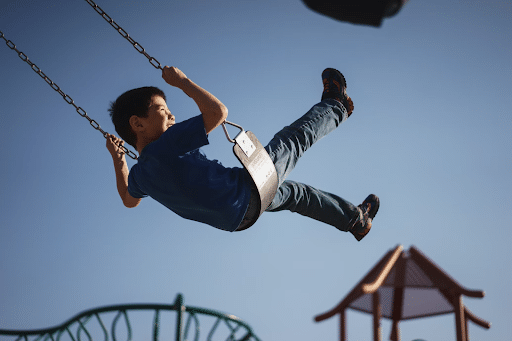Imagine being stuck on a carousel that never stops spinning. This endless ride illustrates the frustrating cycle of constipation and encopresis that many children and their families struggle to deal with.
Kids who have constipation and/or encopresis face periods of relief commonly followed by relapses, ongoing discomfort, and the constant struggle to find a solution. The goal is to help your patients disembark from this relentless cycle and regain control over their bowel health.
In this blog, you will first take a look at the underlying mechanisms of encopresis. Then, you will learn how the application of maintenance therapy for constipation is critical to fully break the vicious cycle and to effectively support your patients on their journey to improved health and wellness. Lastly, you will examine a brief case-study of a 7 year old boy and how he progressed through therapy.

Understanding Pediatric Encopresis
Pediatric encopresis is the involuntary leakage of stool, often resulting from fecal retention and chronic constipation. The condition can be distressing because children often experience temporary relief with disimpaction or laxatives, leading parents to believe all is well, only to later be followed by a return of symptoms.
In previous blog posts, I discussed in depth how to identify functional constipation, and the influence of chronic constipation in encopresis. In this blog, I want to progress your understanding of the medical management of stool retention and encopresis.
Remember, encopresis occurs as a compensatory response to fecal retention. The body is attempting to move stool, so the stool stays loose and leaks out around the impacted stool.

The Roles Of The Anal Sphincters
Let’s take a look at the roles of the internal and external anal sphincters. Understanding these are important for effectively treating encopresis and constipation, as this knowledge helps guide which types of laxatives will be most helpful.
External Anal Sphincter (EAS): If a child feels an urgency to go but can’t hold onto it, this indicates weakness in the EAS. Chronic liquid stool hitting the internal anal sphincter (IAS) can cause the EAS to weaken over time, leading to this issue.
Internal Anal Sphincter (IAS): Fecal incontinence involving gas or liquid typically points to issues with the IAS. If a patient can’t maintain closure for more than 15 minutes, this also implicates the EAS, as these sphincters often function together.
Choosing The Right Laxatives
Understanding which sphincter is primarily affected can guide the choice of laxatives:
- Osmotic Laxatives (e.g., Miralax) help by drawing water into the bowel to soften stool, making it easier to pass. These are useful when there is an issue with the IAS.
- Stimulant Laxatives (e.g., Ex-Lax) increase bowel motility and are helpful when there is a need to stimulate the EAS due to weakness or to increase overall bowel movements.

Fecal Disimpaction And Maintenance Interventions
Effective management of encopresis starts with disimpaction to address the underlying constipation. Many parents believe that once their child has a disimpaction procedure, then all will be resolved. But as you know, constipation has multiple contributing factors, including lifestyle, dietary, and psychological components.
So you need to educate your families on how disimpaction can be a great start to therapy, but that bowel management may take months or even years of maintenance involving laxatives and behavioral therapy. Let’s delve into the goals for your kids’ therapy.
Goals Of Maintenance Therapy
- Implement The Modified O’Regan Protocol (MOP) for constipation, which includes:
- Enemas
- Suppositories
- Osmotic laxatives
- Stimulant laxatives
- Decrease Resting Tone of the Pelvic Floor Muscles: Reducing the pelvic floor’s resting tone helps the muscles better hold stool and effectively contract and relax. This pressure management decreases the rectum’s diameter, reducing pressure on the bladder.
- Increase Bowel Movement Frequency: Aim for 5-7 bowel movements per week of Type 4-5 consistency on the Bristol Stool Scale without straining.
- Encourage Good Toileting Postures: Squatting or using a footstool can help align the rectum for easier stool passage.
Signs Of Progress
You and the child’s parents should monitor the following signs to help gauge the effectiveness of the treatment plan:
- Decreased Stomach Aches: Less abdominal discomfort is a positive indicator of improved bowel function.
- Decreased Urinary Frequency and Urgency: As stool retention improves, pressure on the bladder decreases, reducing these symptoms.
- Decreased Skid Marks: Fewer accidents suggest better control and less leakage.
- Ability to Sense Urge: Developing the ability to recognize the need to go and improving bowel interoception is a critical step in regaining bowel control.
- Spontaneous Bowel Movements Without Enema: Regular, natural bowel movements indicate that the bowel and pelvic floor muscles are functioning more effectively.

The child’s aim should be to achieve regular, daily bowel movements without leaks. If a child’s motility increases to 3-4 bowel movements per day and stool becomes looser, this may indicate the need for adjustment.
The child’s parents need to continuously monitor the child’s stool consistency and make adjustments as needed. This collaborative effort is most effective with regular documentation (bowel and bladder diary) and clear communication between the family, physician, and you.
Case Study: 7-Year-Old Boy with Encopresis and Constipation
Background
Jesse*, a 7-year-old boy, had been struggling with encopresis and constipation for over five years. After an infection, he had been put on a strong antibiotic, which required several cleanouts. Recently referred by a pediatric gastroenterologist, he had a cleanout two weeks before his initial therapy evaluation.
His bowel log of the previous week indicated daily bowel movements of a 6 or 7 on the Bristol Stool Scale.

Laxative Regimen
He was then put on a laxative regimen to included:
- 2 squares of Ex-Lax before bed. Ex-Lax is a stimulant laxative, used to stimulate motility. This resulted in Jesse having bowel movements in the morning, without leaks or streaks.
- 2 caps of Miralax powder in a water bottle. Miralax is an osmotic laxative, used to keep stools soft, making them easier to pass. This helped Jesse to maintain stool softness throughout the day.
Jesse stayed on this regimen for a month. He progressed from having 2 bowel movements per day to 1, which was positive, indicating that his bowel motility was accommodating and slowing down a bit for more efficient evacuation.
Titration Plan And Progress
Jesse’s heavy laxative regimen was prescribed by a more aggressive gastroenterologist, so dehydration and electrolyte imbalances were important to monitor for. If Jesse had started leaking, the laxative dosage may have needed to be titrated. However, Jesse made good progress with this regimen and didn’t show any signs of concern.
The art and science of titration is a skill. This comes with understanding and practice. Gradual reduction of stimulant laxatives is preferred, focusing on maintaining motility without reliance on stimulants. However, if Jesse had slow transit constipation, Ex-Lax may have been needed longer to maintain his bowel motility.
Jesse’s pelvic floor had been affected by 5+ years of maladaptive postural and movement patterns resulting from chronic constipation. So he also participated in pelvic floor retraining, using biofeedback and belly breathing exercises to retrain proper muscular strength and coordination.
Managing encopresis and fecal retention is a long-term process that requires patience and consistency. By implementing effective disimpaction and maintenance strategies, and carefully monitoring progress, you can help children and families finally find resolution from the constipation carousel!
Easier said than done. That’s why in my online Peds Level 2 course, we delve into the details of constipation management using the MOP program.
So if you’ve taken my online Peds Level 1 course, join me in Peds Level 2 – Advanced Pediatric Bowel and Bladder Disorders, where you will develop your clinical reasoning skills through deeper dives into multiple constipation and encopresis case studies.
*patient’s name changed for privacy
